Some clubs worldwide struggle to find a league that matches their abilities, with one proving to be too challenging and seeing them in constant basement battles whilst the next level down is not much of a contest for them. In the Swedish women’s game, AIK Damer could be easily classified in that category, with their recent campaigns seeing them alternate almost on a yearly basis between flirting with Damallsvenskan relegation and sealing progress back to the top tier through finishing in the top two of the Elitettan (the second tier).
Following their relegation last year, 2023 has been a season in which they have been competing for the latter, and it has ultimately not proven to be too arduous a task as they have yet to lose a match and are currently on a 14-game winning run, with eight of those victories also yielding clean sheets.
In short, they have largely controlled proceedings in the second tier this season. This tactical analysis will look in closer detail at how they have managed to do so by breaking down their tactics in both attack and defence and showing how their flexible shape has enabled them to operate freely, thereby making it hard for teams to contain them.
Build-up play
It is evident when looking at those sides who do challenge for titles that having exceptional build-up abilities is a critical skill in allowing them to reach their targets, with every coach recognising that finding a way to manage multiphase situations is essential to succeed on the field. AIK Damer are no different in that regard.
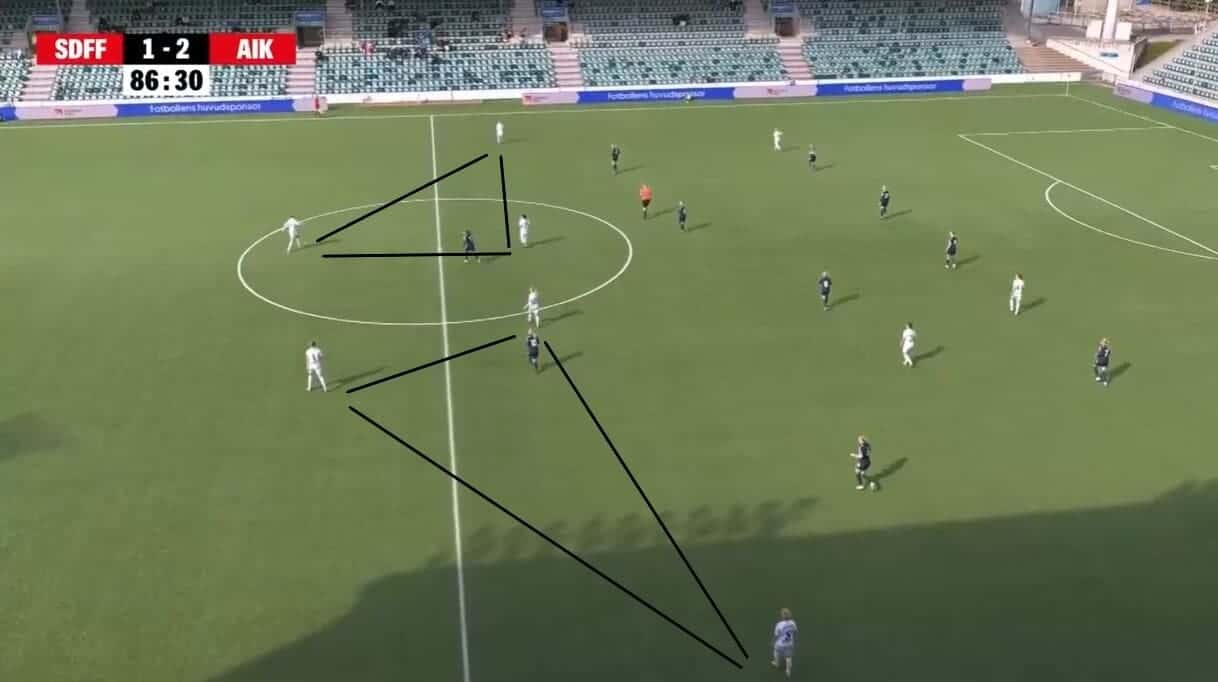
For Jesper Björk’s side, the process of constructing an attacking opportunity begins at the back, with a critical demand of his being that AIK make the pitch as big as possible whenever they have the ball in order to give them the best possible opportunity of implementing their expansive tactics. As such, it is typical for the defensive line to spread from wing to wing whenever they are in possession, as is happening here against Sundsvalls Damer.
However, whilst that will always make it harder for opponents to attempt an interception, it will not automatically allow the ball to travel forwards in the progressive manner that AIK desire, and so there is a need for those ahead of the defensive line to link up with their teammates to facilitate their quick transitions. When they do so, it is expected to see triangular shapes such as these formed, and it is immediately clear how much of a difference that makes in providing AIK with forward passing options.
Their ability to connect in this manner is why they have such a solid passing accuracy, with 77.9% of their efforts finding their intended target during the current campaign. It is clear to see just how difficult that makes them to contain as there are so many possibilities that opponents need to consider, and they can’t cover every one.
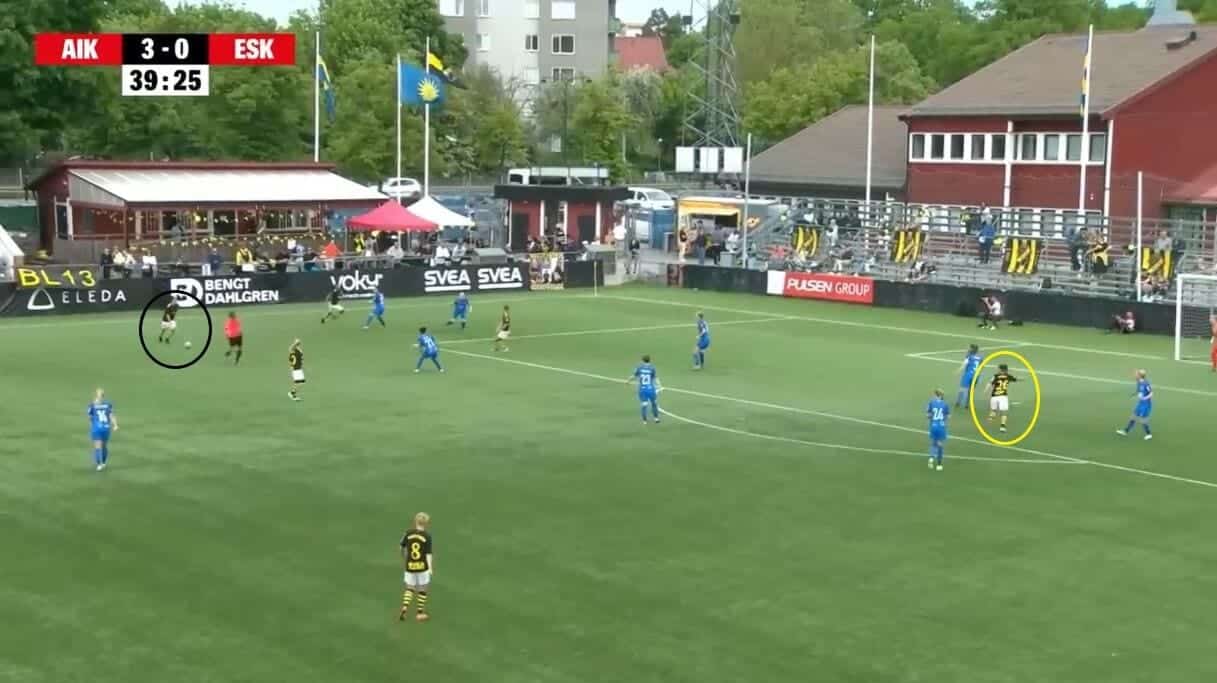
Playing that way does require a great deal of patience, though, as teams who have this mentality have to recognise when there are chances to send the ball into dangerous areas and when they need to be more conservative. Fortunately, this is something that AIK understand well, and it is a theme that runs through so much of their play, which is why they have controlled so many of their games and have averaged 59.07% possession per match in 2023.
This situation illustrates it perfectly, with them inside Eskilstuna United Damer’s half and looking to create a goalscoring opportunity, but recognising that Eskilstuna, like Sundsvalls, have tried to get as many of their players between the ball and their goal as possible and so they will need to force the issue and wait for their chance to come rather than rushing things and increasing the risk of a counterattack.
In the end, what they opt for is to move the ball around on the far side wing for a few seconds, with Michelle Rojas Flores and Matilda Nildén (the younger sister of current Juventus Femminile and Sweden defender Amanda) combining to make that possible, and that has the desired effect as Eskilstuna’s ranks become increasingly stretched and sizeable gaps appear that AIK can now target. At this point, Rojas Flores sends the ball in, targeting the area behind Kim Sundlöv, where Daniella Famili is waiting to connect with it.
Even though this chance doesn’t come to anything as Famili sends it over the bar, the intent was still there, and the patience in their play was demonstrated clearly. and it is this that has really aided AIK in their bid to play on the front foot and control games but to get results whilst doing so.
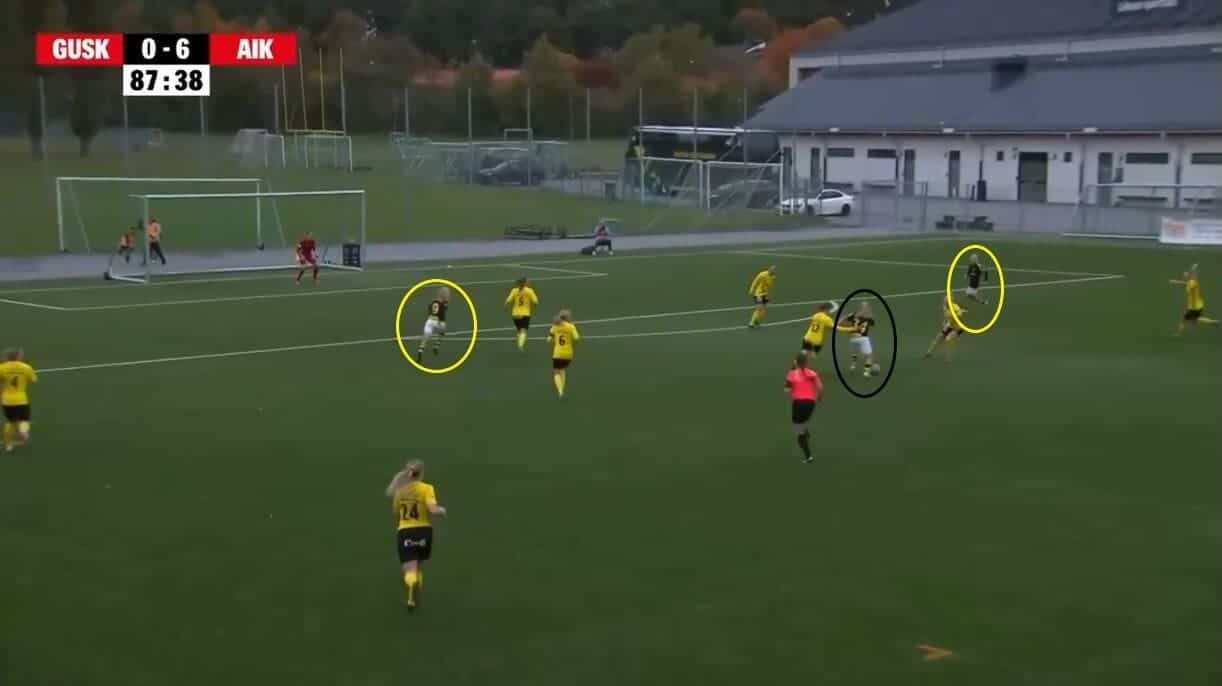
There are other ways that they build chances, though, and one of those comes through the way that their forward line is set up. With AIK favouring a 4-3-3 starting formation under Björk, having deployed it in 85% of their games in 2023, there have always been three players inside the final third whenever they have possession, but what is key is that each has different roles as they try to create natural passing routes for the ball to travel through on its way up the field. As is shown here, the two wide players tend to stay higher up and be the main attacking threats, whilst the central player drops deep to pick up the ball, just as Nova Selin has done here.
The reason that AIK play this way is because they want to again manipulate the opposing defenders into moving out of position and to create again gaps that they can exploit, with the hope being that they will follow the central player and will, therefore, leave space open for the wide forwards to run into as soon as the ball ends up at their feet. In this case, it works perfectly, with Selin under pressure from the Gamla Upsala Dam players but able to feed the ball into Emelie Jansson, who, like Moa Sjöström, is waiting and knows exactly what her role is.
Once again, the chance is not taken as Jansson fires wide of the goal. Still, the fact that she was able to test her luck in the first place demonstrates the effectiveness of this way of playing and shows again how AIK’s build-up play has been instrumental in allowing them to make a return to the Damallsvenskan at the first time of asking.
Flexible shape
Whilst that section of the analysis indicated chances that they failed to take, there is no doubt that AIK Damer have been a very clinical team in front of goal as the campaign has gone on, with them finding the net on 92 occasions in 2023 at an average of 3.83 times per game. One reason for that is the flexible shape they have played with in their bid to make themselves as unpredictable an opponent as possible.

It might seem a little oxymoronic, given that the scout report has already stated that AIK have had a preferred formation during their matches. Still, the simple fact is that, when looking deeper, there has actually been a significant amount of movement and rotation allowed between the players once the matches have got underway. This situation shows that perfectly, with the front three structure there to see, but the key detail being that Nildén drifts towards the middle of the pitch with the ball whilst Adelisa Grabus runs across her path to fill the hole that her teammate had left open.
This movement, particularly among the forwards, has been particularly prevalent when AIK have been counterattacking, with their focus again being on moving up the field at speed but on making sure that spaces are left open for them to use to their advantage and that is one of the reasons that 53.3% of their counterattacks have ended in a shot on the opponents’ goal.
In this case, it again has the desired effect as both Ingrid Wixner and Wilma Stenman are caught on the back foot and are unable to decide in time whether to follow Grabus or to hold their positions, with the result being that AIK play through them with ease and Jansson (currently out of shot) again tests the Upsala goal.
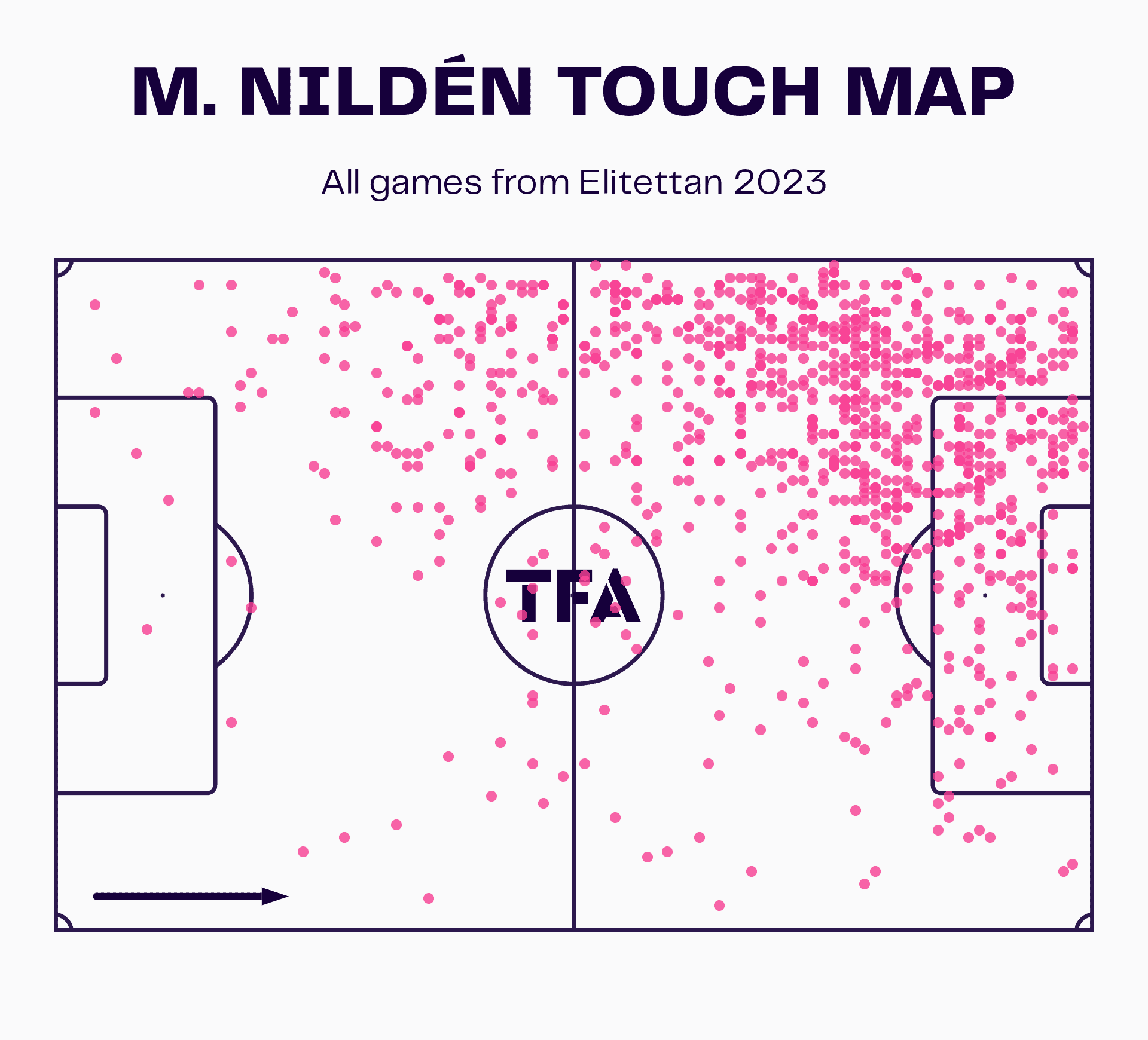
The chance may have also not been successful, but the fact that it came about at all is down to the decisiveness and understanding that both Nildén and Grabus demonstrated, and their ability to change positions simultaneously, and the fact that Upsala were caught out by it in the way that they were shows just how effective it has been.
Nildén, in particular, has really thrived in this aspect of the AIK game plan, with her touch map indicating how many areas of the field she has had possession in, and what is immediately apparent is that she has been active in all three main channels of the field and has epitomised Björk’s desire to have a team that has a structure but that also plays with freedom and flexibility.
She is not the only one who has occupied this amount of territory, but she is the one who tends to act as a playmaker for the team and who is involved in the vast majority of their attacking opportunities as a result.
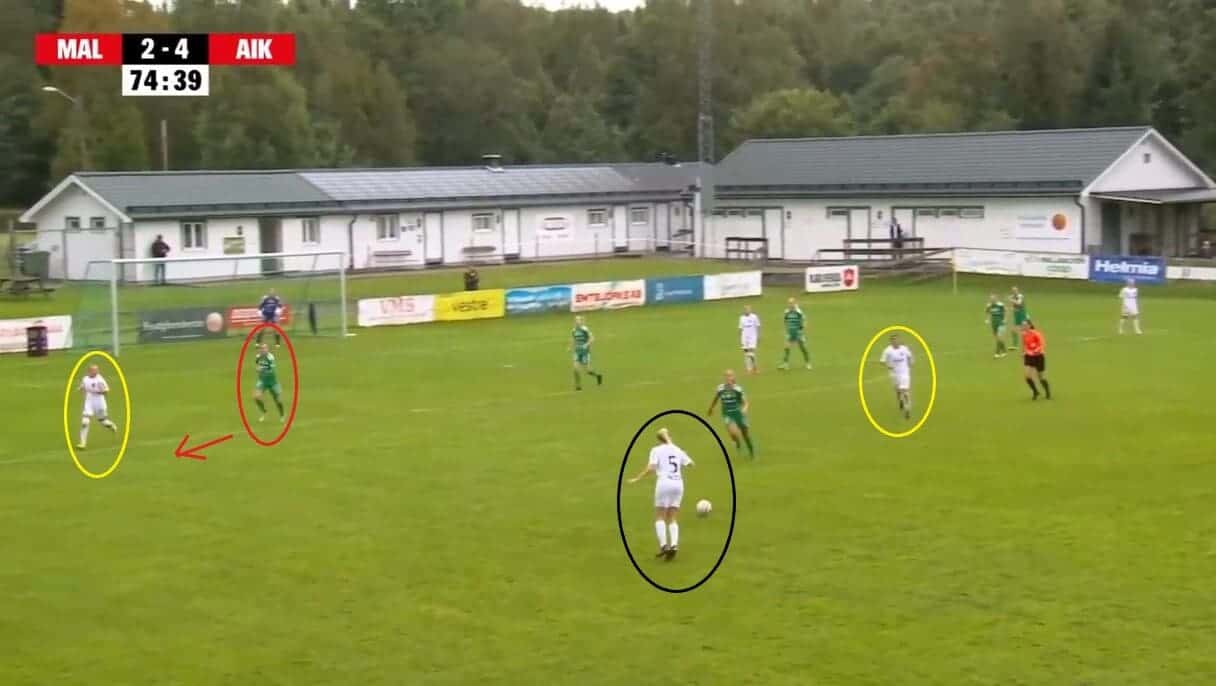
Maintaining this flexible approach to their shape is another reason that AIK have created a wide variety of passing options for each other, with this situation again showing how a triangle has been formed inside Mallbackens’ half. This time, the aim is not to simply move the ball forward but to play with a purpose, in that AIK want to find a way through their opponents and into their goal area.
Therefore, it is perhaps more apparent here to predict where the ball will go, with Laura Juul Hansen having Rojas Flores inside her and Nildén directly ahead. However, there is still an element of doubt that is planted in the defenders’ minds due to her open stance, meaning that no options are yet off the table.
In this case, she does do as expected, with the ball travelling towards Nildén, and it pays dividends for AIK as they are able to draw Linnéa Berger out of position and to create additional space for them to move the ball into the middle from.
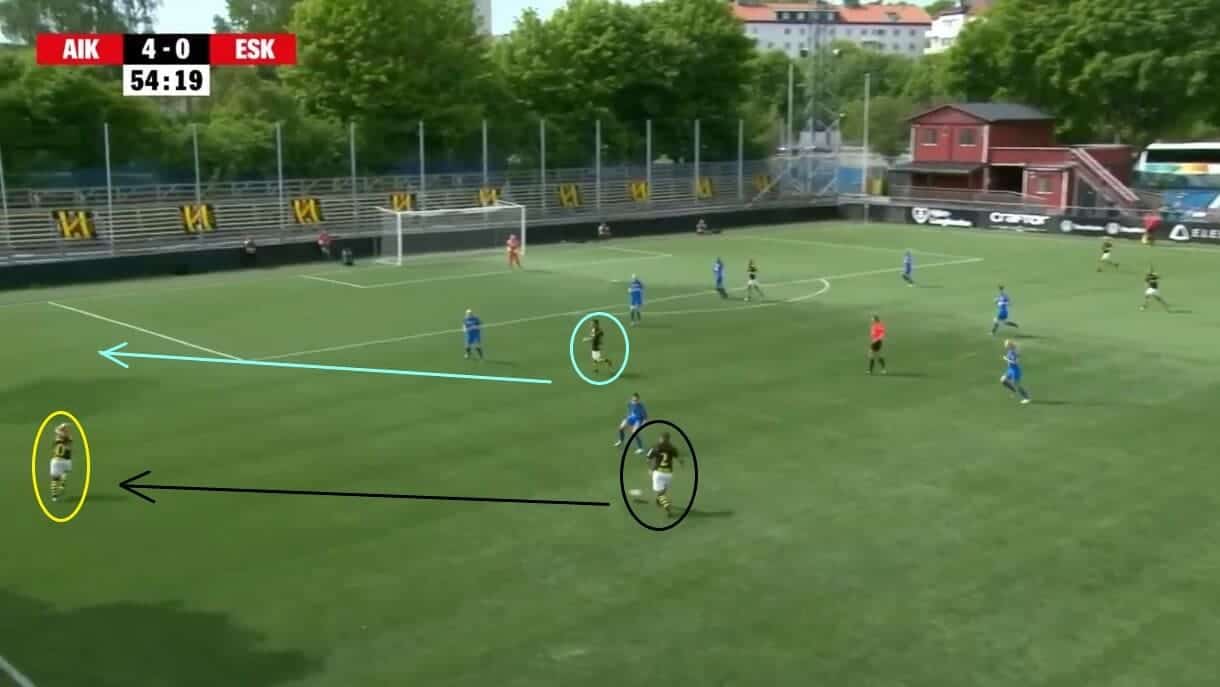
The patient approach to their play also comes into the equation when looking at AIK’s flexible shape. They often look to use the natural advantages of their 4-3-3 formation to retain the ball and build slowly through players moving around and offering different options before sending the ball into the middle.
The critical detail they rely on here is that the 4-3-3 gives teams a traditional full-back, wide midfielder and wide forward on the field, allowing them to have three players capable of operating on the wings. This situation shows how AIK use that, with Annika Svensson shifting the ball towards Nildén before Rojas Flores then moves out to continue the progression up the wing.
Again, Eskilstuna are looking here to remain compact in the middle, which is why AIK are having to show patience and wait again for the right opportunity to come their way. They are rewarded on this occasion as the eventual delivery from Rojas Flores is turned into the net by Famili inside the goal area. However, there is little doubt that none of this would have been possible had AIK’s players not had the freedom to roam around the field and to get into these positions, which again shows why that has been such an essential part of their successful promotion bid.
Defensive tactics
Whilst it is widely accepted that AIK Damer have been a ferocious side in attack and one that has frequently made the most of their opportunities, it is also essential to look at their defensive play and to see how they have made themselves robust whenever they have not had the ball, as that has played just as significant a role in their success.
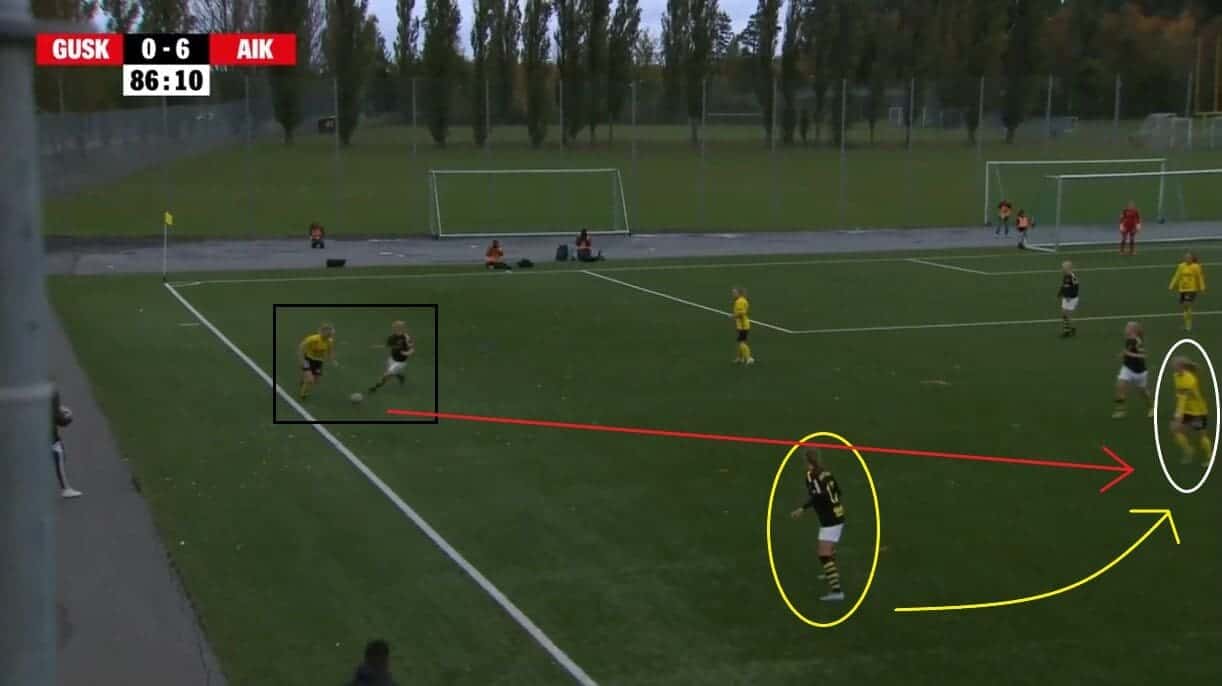
Just as the build-up play begins at the back, defending starts at the front, with AIK’s mentality instantly changing as soon as possession has been lost, and that is indicated here by the way that Juul Hansen has moved out towards Sofia Nilsson here and has instantly looked to decrease her options before the Upsala player has even had a moment to assess them.
However, the player to really look at here is Finnish defender Silja Jaatinen, who only joined the club from TPS Naiset in her home country (based in the city of Turku) at the end of August. Here, she plays the vital role in holding back and looking at where the next phase of the attack will be, and that allows her to close down Sofia Paulsson as soon as the ball arrives at her feet, dislodging the ball and preventing Upsala from gaining any more territory whilst at the same time allowing her team to get back on the front foot and to push back up the field once more.
The second phase of defending is always something that AIK have greatly emphasised during their matches. It has undoubtedly served them well when looking at this situation and how it could have gone had they not been so quick to assess where the threat was and to ensure that they were in the right place at the right time to bring it to a swift end.
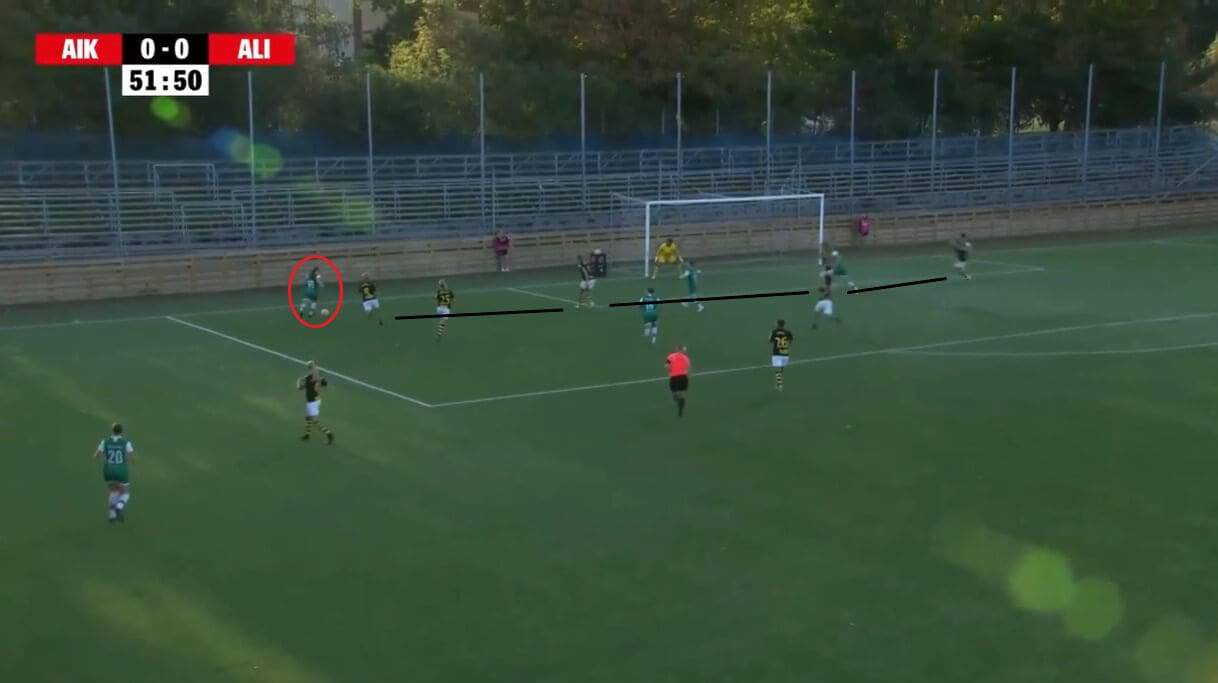
When the ball does progress into their third, AIK do have more conventional ways of limiting opponents’ options, though, with them playing with an organised back line that limits opponents’ options as they try to increase the chance of them regaining the ball and launching one of their counterattacks above.
In this case, it is Alingsås Damer’s Alma Öberg who has made her way into their goal area, but her options now are limited by the unified back line that AIK have alongside her, with no gaps open and no easy ways for the ball to move into the middle. As a result, Öberg’s only option is to try her luck from the tight angle, which ends with goalkeeper Serina Backmark gathering the ball with ease once it comes into her vicinity.
Given that this was one of the tighter matches in the season for AIK, with them only winning 1-0 after Nildén had scored in the 69th minute, moments like this were crucial and ultimately decisive in allowing them to secure another three points. It shows how, even when they did look to be under pressure, they were always in control of what was happening and were, therefore, able to gain the points needed to make an immediate return to the Damallsvenskan.
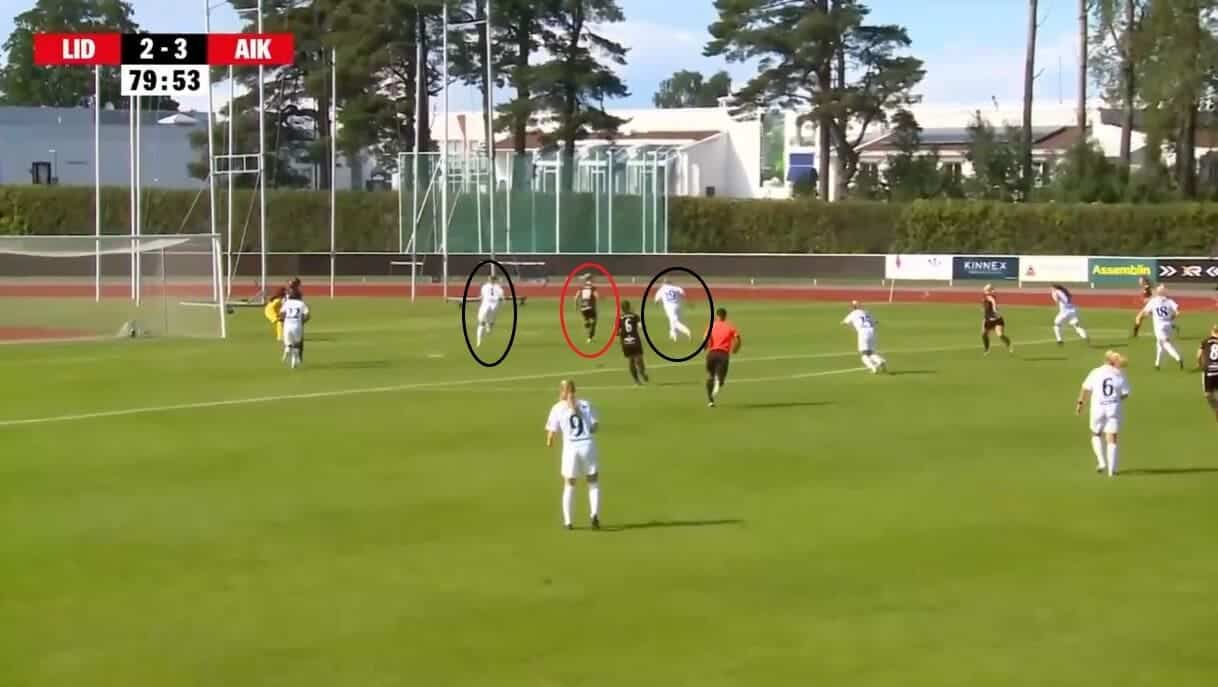
However, they are not perfect, and there have been times when they have not been able to form or retain that shape, which has led to a few nervy moments and some goals being scored against them (they have conceded 14 so far, at an average of 0.58 per game).
In those situations, though, they have often turned to individual instinct to contain potential danger, with the trip to Lidköpings one of those games when they were under opposing severe pressure.
What is critical about AIK is that they adapt really well when they need to, and that was what allowed them to deal with this attack and to stop Lidköpings from gaining a crucial equaliser through Ann Öhman, with central defenders Jennie Nordin and Julia Laukström teaming up to isolate her and to prevent her from having a viable shot on goal. AIK have won 70.1% of their defensive duels and 56.2% of their aerial battles during 2023, and it is not hard to see why when looking at these situations and how they managed them, and it shows again why they have been so dominant in the Elitettan this season.
Conclusion
In conclusion, this tactical analysis has looked in detail at AIK Damer and their successful bid for promotion back to the Damallsvenskan, ending their one-year hiatus from the top flight and winning the Elitettan title in the process of doing so with two games to spare. As has been shown throughout the analysis, there has been a lot to like about their attacking and defensive play this season. There will undoubtedly be a lot of positivity around how Björk wants them to play and how effective his tactics can be in making the team as dangerous as possible at the top of the field and showing resilience at the back.
For their fans, there will be a lot of hope that this latest promotion is the last that they will need to secure for a while, with the aim surely being to ensure a more extended stay in the top tier now that they are back in it. AIK are not the strongest side in Sweden by any stretch, but are a club with a rich history when it comes to the calibre of players who have worn their shirt, with the likes of Manchester City midfielder Filippa Angeldahl, Everton Women defender Natalie Björn and Australia legend Kate Gill just some of those to have featured for them in the past.
The task for the current crop will be to avoid an immediate return to the second tier and to give themselves instead a platform to build on for the future, emulating some of those names. Still, they will be all too aware of the difficulty of doing so, and there is no doubt that challenges lie ahead for them as they try to re-establish themselves as a mainstay in the top tier.





Comments